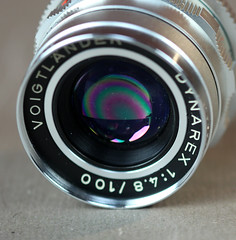Lens separation

|
| Lens having separated elements indicated by the bands of spectral colors. image by Frank Reiser (Image rights) |
Lens separation is a type of damage occurring when the adhesive properties of the cement holding two lenses together fails. Air then enters the narrow space between the lens elements previously filled by the optical glue. The adhesives used have a refractive property similar to glass so the junction between the two optical elements is invisible. After the lens adhesive breaks down it results in a glass-air-glass interface, which if narrow enough, will diffract light into its spectral components producing a rainbow-like effect as a thin film of oil on water does.
Light traveling through a transparent medium slows down a certain amount in relation to the substance's density. Depending on the light ray's striking angle to the glass surface, it will bend to a definite degree for that material. This characteristic is mathematically expressed as "refractive index" an essential factor used when designing lenses. Chromatic aberration, seen as color fringing along the edges of a lens projected image, is controlled by combining lenses of different glass densities with refractive indices and curvatures to manipulate as much of light's full spectrum to fall together in the focused image as possible.
The performance of a lens showing signs of lens separation will produce images falling short of how the lens was designed to perform.